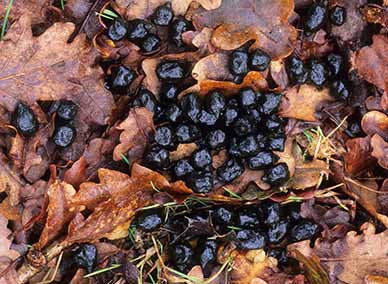Deer field signs - droppings

deer have passed along the way
The study of animal droppings is not to everybody's liking, but droppings provide a useful indication that deer are present, and may even help identify the species. Size is a crucial clue, whilst other characteristics help build a more complete picture.
Unfortunately, though, not all droppings exhibit the standard characteristics popularly associated with each species. Diet, condition and size of the animal all have an influence, but used in combination with other field signs, a knowledge of dropping characteristics can be a useful tool in the nature detective's armoury.
Fallow Deer: medium size droppings, 1 - 1.5 centimetres x .8 - 1.2 centimetres, oval shape similar to those of red deer, black changing to brown.
Red Deer: large droppings, 2 - 2.5 centimetres x 1.3 - 1.8 centimetres, initially black and shiny, gradually becoming duller and more dark brown, cylindrical / acorn-shaped, often pointed at one end, rounded or slightly concave at the other.
Roe Deer: small droppings: 1 - 1.4 centimetres x 0.7 - 1 centimetre, shiny, nearly black and glossy when fresh, cylindrical pellets often pointed at one end, the other end rounded.
Sika Deer: medium size droppings, 1 - 1.5 centimetres x .8 - 1.2 centimetres, glossy black, one end flat, indented or rounded, the other pointed.
Reeves muntjac: small droppings, 1 - 1.3 centimetres x .5 - 1.1 centimetres, black, rounded or cylindrical and sometimes with a point at one or both ends.
New Forest deer field signs - find out lots more
New Forest deer - find out lots more
References:
The History of British Mammals: Derek Yalden
Roe Deer: John K. Fawcett, British Deer Society
New Forest Roe Deer: John K. Fawcett
Deer Watch: Richard Prior
Mammals of Britain and Europe: David McDonald, Priscilla Barret
Field Guide to British Deer: F J Taylor Page
More links
Other related links
Search this site

Sadly, 58 animals were killed - 35 ponies, 13 cows, 8 donkeys and 2 sheep, whilst a further 32 were injured - 3 pigs, 9 donkeys, 11 cows and 9 ponies.
(Forty-three accidents occurred in daylight, 15 at twilight and 101 in the dark. Twenty-seven accidents were not reported by the driver involved).
Here's just one horrific example - Three donkeys killed in collision with van at notorious New Forest blackspot (Advertiser and Times)

